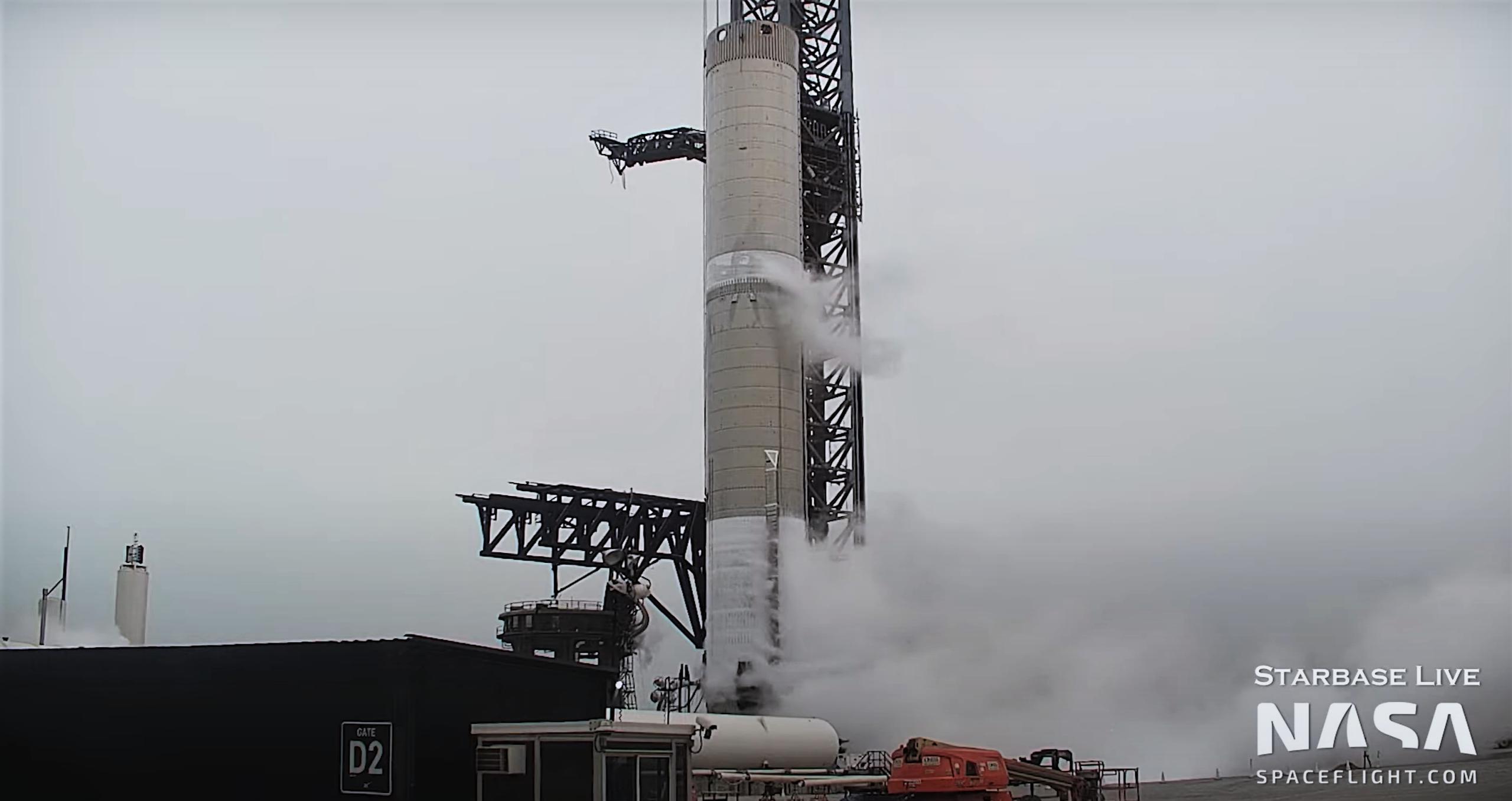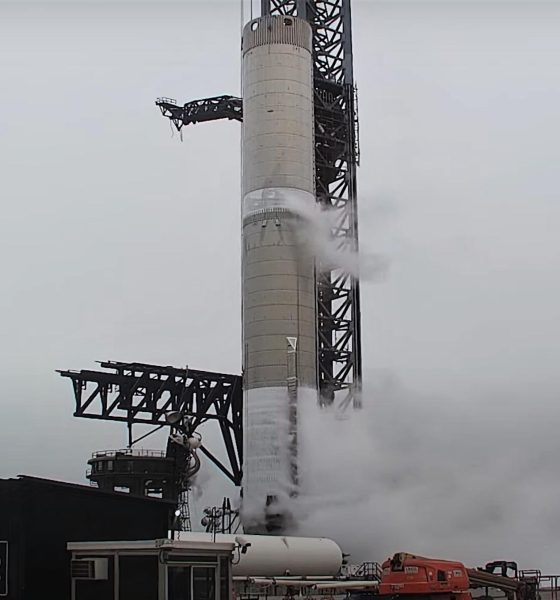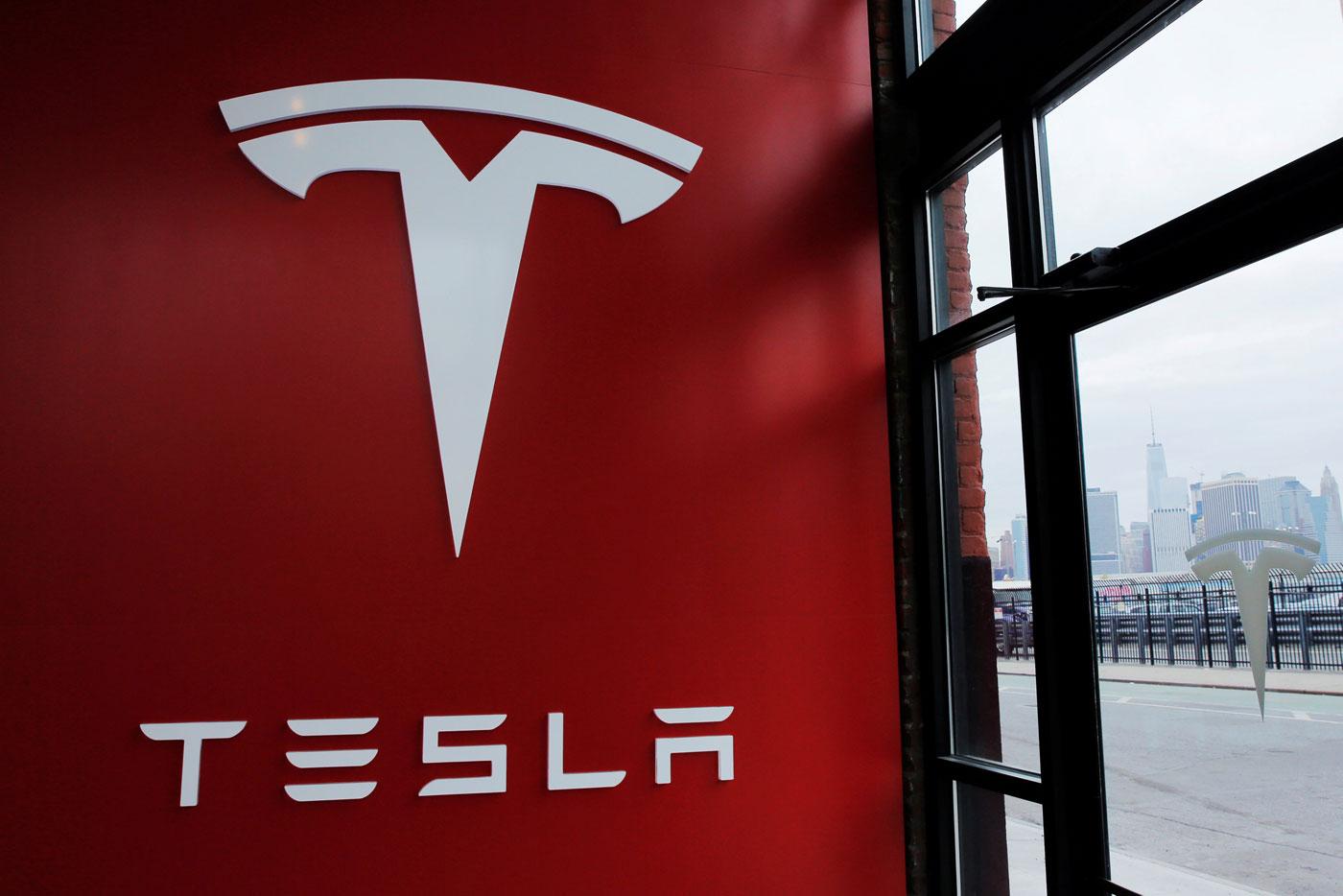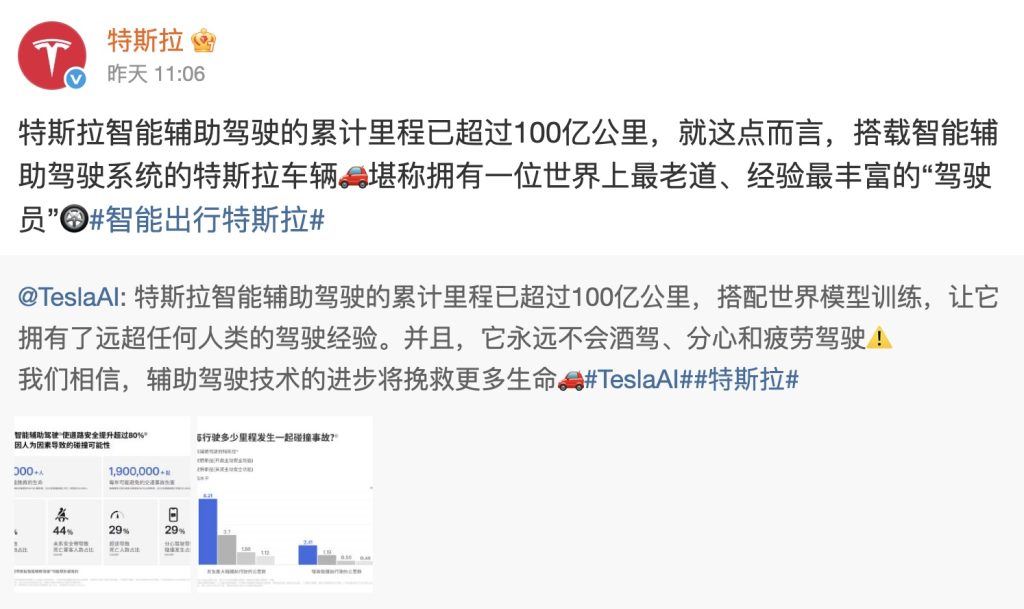

News
SpaceX begins stress-testing upgraded Super Heavy booster
In a what is likely a prelude to engine installation, SpaceX has begun stress-testing an upgraded Super Heavy booster prototype.
Known as Super Heavy Booster 7 or B7, the prototype is the first of its kind designed to support up to 33 new Raptor V2 engines – each potentially capable of producing up to 230 tons (~510,000 lbf) of thrust at liftoff. Even with just 20 such engines installed, Super Heavy – measuring around 69 meters (~225 ft) tall and nine meters (~30 ft) wide – will be the largest and most powerful rocket stage ever tested. That potentially unprecedented power is why SpaceX has custom-built a complex structural test stand to explore Super Heavy’s true performance envelope in a slightly less risky manner.
In the second half of 2021, that structural test stand briefly tested an unusual half-Starship, half-Super Heavy test tank with a nine-engine thrust section (‘puck’) and later compressed a different test tank until its reinforced steel skin buckled. In the interim, SpaceX removed its nine-ram setup and modified the stand to support 13 rams, guaranteeing that its new purpose was to test Super Heavy’s new 13-engine thrust section. Prior to Booster 7, all Super Heavy prototypes have had a similar nine-engine puck and an outer ring of 20 engines that would attach directly to the rim of each booster’s cylindrical body.
Increasing the central engine count from 9 to 13 was already certain to up the amount of stress future Super Heavy thrust pucks would need to survive by almost 45%. But combined with Raptor V2’s thrust increases, Super Heavy Booster 7’s thrust puck could actually be subjected to at least 80% more thrust at liftoff. Altogether, Super Heavy B7’s 33 engines should be able to produce ~7600 tons (~16.8M lbf) of thrust compared to Super Heavy B4’s ~5400 tons (~11.9M lbf). As a result, though it’s odd that SpaceX never did significantly test Booster 4, it’s no surprise that the company chose to give Booster 7 priority as soon it was ready.
After a few false starts and at least one ‘pneumatic proof test’ that likely saw Booster 7 pressurized with benign nitrogen gas, SpaceX began stress-testing the upgraded Super Heavy in earnest on April 14th. First, the booster was filled about a third of the way with roughly 1000 tons (~2.2M lb) of liquid nitrogen (LN2) or a combination of liquid oxygen (LOx) and LN2. Once the rocket was fully chilled, there were clear signs of some kind of added stress as large sheets of ice that had formed on the side of B7’s skin broke apart and fell off.
Only ice close to Super Heavy’s base was visibly disturbed, increasing the odds that the behavior was a sign of some or all of the structural test stand’s hydraulic rams simulating Raptor engines. It’s also possible that the stress was caused by pressurizing Super Heavy’s tanks to the point that they began to appreciably deform, though that type of testing is far harder to differentiate. Without official comments, it’s unfortunately impossible to ever know what exactly SpaceX is testing or how successful those tests are when the structural test stand is involved.
Nonetheless, it’s likely that Booster 7 isn’t done with the stand just yet. SpaceX could benefit from just about any data gathered about the performance of Super Heavy’s new thrust puck during simulated Raptor startup, throttling, and shutdown both at liftoff and during boostback and landing burns. SpaceX might also want to simulate engine-out scenarios that would result in asymmetric thrust.
Assuming Booster 7 survives this particular series of tests and SpaceX is happy with its performance on the structural test stand, the upgraded Super Heavy could be ready for Raptor installation and integrated wet dress rehearsal and static fire testing in the near future. SpaceX began delivering upgraded Raptors V2 engines to Starbase in late March.

News
Tesla accused of infringing robotics patents in new lawsuit

Tesla is being accused of infringing robotics patents by a company called Perrone Robotics, which is based out of Charlottesville, Virginia.
The suit was filed in Alexandria, Virginia, and accuses Tesla of knowingly infringing upon five patents related to robotics systems for self-driving vehicles.
The company said its founder, Paul Perrone, developed general-purpose robotics operating systems for individual robots and automated devices.
Perrone Robotics claims that all Tesla vehicles utilizing the company’s Autopilot suite within the last six years infringe the five patents, according to a report from Reuters.
Tesla’s new Safety Report shows Autopilot is nine times safer than humans
One patent was something the company attempted to sell to Tesla back in 2017. The five patents cover a “General Purpose Operating System for Robotics,” otherwise known as GPROS.
The GPROS suite includes extensions for autonomous vehicle controls, path planning, and sensor fusion. One key patent, U.S. 10,331,136, was explicitly offered to Tesla by Perrone back in 2017, but the company rejected it.
The suit aims to halt any further infringements and seeks unspecified damages.
This is far from the first suit Tesla has been involved in, including one from his year with Perceptive Automata LLC, which accused Tesla of infringing on AI models to interpret pedestrian/cyclist intent via cameras without licensing. Tesla appeared in court in August, but its motion to dismiss was partially denied earlier this month.
Tesla also settled a suit with Arsus LLC, which accused Autopilot’s electronic stability features of infringing on rollover prevention tech. Tesla won via an inter partes review in September.
Most of these cases involve non-practicing entities or startups asserting broad autonomous vehicle patents against Tesla’s rapid iteration.
Tesla typically counters with those inter partes reviews, claiming invalidity. Tesla has successfully defended about 70 percent of the autonomous vehicle lawsuits it has been involved in since 2020, but settlements are common to avoid discovery costs.
The case is Perrone Robotics Inc v Tesla Inc, U.S. District Court, Eastern District of Virginia, No. 25-02156. Tesla has not yet listed an attorney for the case, according to the report.
News
Tesla has passed a critical self-driving milestone Elon Musk listed in Master Plan Part Deux
Tesla China announced that the company’s Autopilot system has accumulated 10 billion kilometers of driving experience.

Tesla has passed a key milestone, and it was one that CEO Elon Musk initially mentioned more than nine years ago when he published Master Plan, Part Deux.
As per Tesla China in a post on its official Weibo account, the company’s Autopilot system has accumulated over 10 billion kilometers of real-world driving experience.
Tesla China’s subtle, but huge announcement
In its Weibo post, Tesla China announced that the company’s Autopilot system has accumulated 10 billion kilometers of driving experience. “In this respect, Tesla vehicles equipped with Autopilot technology can be considered to have the world’s most experienced and seasoned driver.”
Tesla AI’s handle on Weibo also highlighted a key advantage of the company’s self-driving system. “It will never drive under the influence of alcohol, be distracted, or be fatigued,” the team wrote. “We believe that advancements in Autopilot technology will save more lives.”
Tesla China did not clarify exactly what it meant by “Autopilot” in its Weibo post, though the company’s intense focus on FSD over the past years suggests that the term includes miles that were driven by FSD (Beta) and Full Self-Driving (Supervised). Either way, 10 billion cumulative miles of real-world data is something that few, if any, competitors could compete with.


Elon Musk’s 10-billion-km estimate, way back in 2016
When Elon Musk published Master Plan Part Deux, he outlined his vision for the company’s autonomous driving system. At the time, Autopilot was still very new, though Musk was already envisioning how the system could get regulatory approval worldwide. He estimated that worldwide regulatory approval will probably require around 10 billion miles of real-world driving data, which was an impossible-sounding amount at the time.
“Even once the software is highly refined and far better than the average human driver, there will still be a significant time gap, varying widely by jurisdiction, before true self-driving is approved by regulators. We expect that worldwide regulatory approval will require something on the order of 6 billion miles (10 billion km). Current fleet learning is happening at just over 3 million miles (5 million km) per day,” Musk wrote.
It’s quite interesting but Tesla is indeed getting regulatory approval for FSD (Supervised) at a steady pace today, at a time when 10 billion miles of data has been achieved. The system has been active in the United States and has since been rolled out to other countries such as Australia, New Zealand, China, and, more recently, South Korea. Expectations are high that Tesla could secure FSD approval in Europe sometime next year as well.
Elon Musk
SpaceX maintains unbelievable Starship target despite Booster 18 incident
It appears that it will take more than an anomaly to stop SpaceX’s march towards Starship V3’s refinement.

SpaceX recently shared an incredibly ambitious and bold update about Starship V3’s 12th test flight.
Despite the anomaly that damaged Booster 18, SpaceX maintained that it was still following its plans for the upgraded spacecraft and booster for the coming months. Needless to say, it appears that it will take more than an anomaly to stop SpaceX’s march towards Starship V3’s refinement.
Starship V3 is still on a rapid development path
SpaceX’s update was posted through the private space company’s official account on social media platform X. As per the company, “the Starbase team plans to have the next Super Heavy booster stacked in December, which puts it on pace with the test schedule planned for the first Starship V3 vehicle and associated ground systems.”
SpaceX then announced that Starship V3’s maiden flight is still expected to happen early next year. “Starship’s twelfth flight test remains targeted for the first quarter of 2026,” the company wrote in its post on X.
Elon Musk mentioned a similar timeline on X earlier this year. In the lead up to Starshp Flight 11, which proved flawless, Musk stated that “Starship V3 is a massive upgrade from the current V2 and should be through production and testing by end of year, with heavy flight activity next year.” Musk has also mentioned that Starship V3 should be good enough to use for initial Mars missions.
Booster 18 failure not slowing Starship V3’s schedule
SpaceX’s bold update came after Booster 18 experienced a major anomaly during gas system pressure testing at SpaceX’s Massey facility in Starbase, Texas. SpaceX confirmed in a post on X that no propellant was loaded, no engines were installed, and personnel were positioned at a safe distance when the booster’s lower section crumpled, resulting in no injuries.
Still, livestream footage showed significant damage around the liquid oxygen tank area of Booster 18, leading observers to speculate that the booster was a total loss. Booster 18 was among the earliest vehicles in the Starship V3 series, making the failure notable. Despite the setback, Starship V3’s development plans appear unchanged, with SpaceX pushing ahead of its Q1 2026 test flight target.








